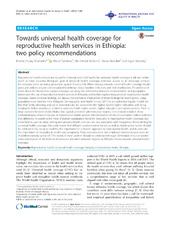| dc.description.abstract | Abstract Reproductive health services are crucial for maternal and child health, but universal health coverage is still not within reach in most societies. Ethiopia’s goal of universal health coverage promises access to all necessary services for everyone while providing protection against financial risk. When moving towards universal health coverage, health plans and policies require contextualized knowledge about baseline indicators and their distributions. To understand more about the factors that explain coverage, we study the relationship between socioeconomic and geographic factors and the use of reproductive health services in Ethiopia, and further explore inequalities in reproductive health coverage. Based on these findings, we discuss the normative implications of these findings for health policy. Using population-level data from the Ethiopian Demographic and Health Survey (2011) in a multivariate logistic model, we find that family planning and use of antenatal care are associated with higher wealth, higher education and being employed. Skilled attendance at birth is associated with higher wealth, higher education, and urban location. There is large variation between Addis Ababa (the capital) and other administrative regions. Concentration indices show substantial inequalities in the use of reproductive health services. Decomposition of the concentration indices indicates that difference in wealth is the most important explanatory factor for inequality in reproductive health coverage, but other factors, such as urban setting and previous health care use, are also associated with inequalities. When aiming for universal health coverage, this study shows that different socioeconomic factors as well as health-sector factors should be addressed. Our study re-confirms the importance of a broader approach to reproductive health, and in particular the importance of inequality in wealth and geography. Poor, non-educated, non-employed women in rural areas are multidimensionally worse off. The needs of these women should be addressed through elimination of out-of-pocket costs and revision of the formula for resource allocation between regions as Ethiopia moves towards universal health coverage. | en_US |

